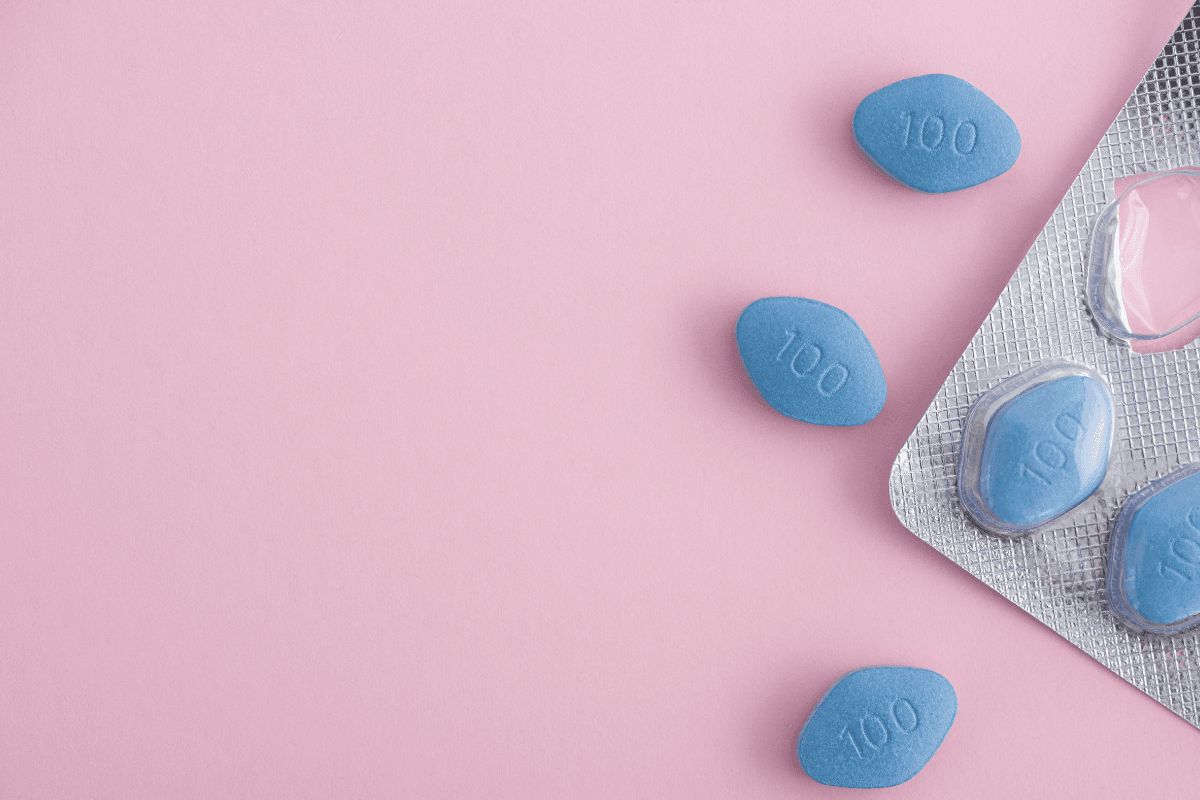Erectile dysfunction (ED) affects an estimated 150 million men worldwide, with prevalence expected to double by 2025, according to a study published in the Journal of Clinical Urology. For many, treatment with oral medications has restored confidence, intimacy, and quality of life. Two of the most commonly prescribed options are Sildenafil and Tadalafil, both belonging to the class of phosphodiesterase type 5 (PDE5) inhibitors.
While both drugs improve erectile function, they differ in how quickly they work, how long they last, and what side effects may occur. Understanding Sildenafil vs Tadalafil is essential to help patients choose the best lifestyle and medical options.
What Is Sildenafil?
Sildenafil, most widely known under the brand name Viagra, was the first PDE5 inhibitor approved for ED treatment in 1998. It works by increasing blood flow to the penis during sexual stimulation, allowing men with ED to achieve and maintain erections. Doctors often explain that it enhances the natural erection process rather than directly causing one. Clinical studies show that Sildenafil is effective in 60–80% of men, making it a reliable first-line therapy.
What Is Tadalafil?
Tadalafil is another PDE5 inhibitor, but is distinct for its extended half-life. While Sildenafil typically lasts 4–6 hours, Tadalafil is known for its duration up to 36 hours, earning it the nickname “the weekend pill.” This long window provides greater flexibility, allowing men to engage in sexual activity without the need for precise timing. Like Sildenafil, Tadalafil requires sexual stimulation to work and does not increase sexual desire. Its long-lasting effect makes it a preferred choice for men who want spontaneity in their relationships.
Onset of Action: How Fast Do They Work?
When comparing Sildenafil vs Tadalafil, one of the most practical differences patients notice is how quickly the medication begins to work. Sildenafil is generally absorbed into the bloodstream within 30–60 minutes after ingestion, which means most men can expect results about an hour after taking the pill. It should be taken on an empty stomach to achieve its best effect, since a heavy or high-fat meal can slow absorption and reduce its effectiveness. This makes timing critical for patients who take Sildenafil; they may need to plan sexual activity around meals and the medication’s onset.
Tadalafil works a bit differently. It usually takes effect within 60–120 minutes, so the onset is slower than Sildenafil. However, one of its significant advantages is that food does not interfere significantly with absorption. Whether taken with or without a meal, Tadalafil maintains its effectiveness, which allows greater flexibility and spontaneity. For this reason, men who prefer not to coordinate pill-taking with mealtimes often find Tadalafil more convenient.
It’s also worth noting that individual responses vary. Some men may notice Sildenafil working faster than the typical 30 minutes, while others might need closer to an hour or more. Similarly, while Tadalafil is often said to “take longer,” some patients report noticeable results within the first hour. The key difference is that once Tadalafil begins working, its effects remain available for up to 36 hours, compared to the shorter 4–6 hour window of Sildenafil.
Duration of Effect: Short-Term vs Long-Term Options
One of the most significant Sildenafil vs Tadalafil differences is how long their effects last. The duration of action can influence whether a medication is better suited for planned intimacy or for more flexibility and spontaneity. Understanding this distinction helps patients choose the best option for their lifestyle and relationship needs.
Sildenafil
- Provides about 4–6 hours of reliable effect
- Best for men who prefer to plan sexual activity within a shorter window
Tadalafil
- Lasts up to 36 hours, offering more freedom and flexibility
- Can be prescribed in lower daily doses for continuous readiness
Dosage Guidelines
Correct dosing is essential to ensure safety and effectiveness when using ED medications. While both Sildenafil and Tadalafil improve erectile function, they differ in how they are prescribed and how often they can be taken. Understanding Tadalafil vs Sildenafil dosage helps patients use the medications responsibly and achieve the best results.
Sildenafil Dosage
- Typical range: 25 mg to 100 mg, taken about an hour before sexual activity
- Most patients start at 50 mg, with adjustments based on response and tolerance
- Should not be taken more than once in 24 hours
Tadalafil Dosage
- As-needed dose: 10–20 mg, effective for up to 36 hours
- Daily dose: 2.5–5 mg, maintains steady therapeutic levels
- Offers flexibility for patients who prefer ongoing readiness without planning around medication timing
Effectiveness and Clinical Outcomes
When assessing Tadalafil and Sildenafil, both medications have proven highly effective, with clinical trials showing success rates between 70–85% for improved erectile function. Sildenafil often demonstrates slightly higher short-term effectiveness, making it a preferred choice for men who prioritize rapid results. Tadalafil, however, is valued for its long half-life of up to 36 hours, which allows more flexibility and reduces the need for precise timing. The option of a lower daily dose further enhances convenience for men who prefer ongoing readiness rather than situational use.
Safety and Side Effects
When comparing Tadalafil vs Sildenafil side effects, both are well tolerated, but the choice may depend on personal tolerance and lifestyle. For instance, men who engage in physical labor may find Tadalafil’s backache side effect more bothersome, while others might dislike Sildenafil’s visual changes.
Sildenafil Side Effects
- Headache
- Flushing (warmth or redness in the face/neck)
- Nasal congestion
- Indigestion (upset stomach)
- Visual disturbances, such as a bluish tint to vision (less common)
Tadalafil Side Effects
- Back pain
- Muscle aches
- Headache
- Indigestion
- Rarely, vision changes
Contraindications and Safety Precautions
Neither Sildenafil nor Tadalafil should be taken with nitrates (used for chest pain) or certain blood pressure medications, as the combination can cause dangerous drops in blood pressure. Men with severe heart disease, recent stroke, or uncontrolled hypertension should consult a doctor before starting treatment. Always disclose all medications and supplements to your physician to avoid drug interactions.
Cost and Accessibility
Sildenafil is available as a generic, making it relatively affordable. Tadalafil is also available in generic form but may cost slightly more due to its longer action. Insurance coverage varies, but many patients consider cost a deciding factor. Online pharmacies and telehealth platforms have increased accessibility, but patients should ensure they are using licensed providers to avoid counterfeit medications.
Lifestyle Considerations in Choosing Between Them
The decision between Sildenafil vs Tadalafil often comes down to lifestyle. Sildenafil is ideal for men who want a reliable, shorter-term solution that can be timed around intimacy. Tadalafil is better for men who value spontaneity or prefer a once-daily option. Depending on patient feedback and treatment goals, Doctors may recommend switching between the two.
For men managing erectile dysfunction over the long term, both cost and convenience are important considerations. You can find affordable, high-quality prescription options, including Sildenafil and Tadalafil, through trusted providers that ensure privacy and reliable service. Explore our ED Medications Product Page to learn more, compare treatments, and order easily and confidently.
Conclusion
Both Sildenafil and Tadalafil are effective treatments for erectile dysfunction, but they offer different advantages. Sildenafil provides a rapid onset and is cost-effective, while Tadalafil offers extended duration and flexibility. By understanding the unique properties, dosages, and side effect profiles of each, patients and providers can make an informed decision tailored to individual needs. Choosing between Sildenafil vs Tadalafil is ultimately about balancing effectiveness, convenience, and safety for the best possible outcome.
Frequently Asked Questions (FAQs)
Can lifestyle changes improve ED along with medication?
Yes, lifestyle adjustments such as regular exercise, quitting smoking, and maintaining a healthy weight can enhance the effectiveness of ED medications. These changes also improve overall cardiovascular health, which directly impacts erectile function. Many doctors recommend combining medication with healthy habits for the best outcomes.
Is it safe to buy ED medications online?
It can be safe if the pharmacy is licensed and requires a prescription. Unfortunately, counterfeit medications are common online and may be ineffective or dangerous. Always verify the source and consult your doctor before ordering.
How long do I need to stay on ED medication?
The duration of treatment depends on individual response and the underlying causes of ED. Some men may only need short-term therapy, while others require ongoing treatment. Your doctor will reassess periodically to determine the best long-term plan.
Do Sildenafil or Tadalafil affect fertility?
Neither medication directly impacts sperm count or fertility. However, improving erectile function may enhance the chances of conception in couples trying to conceive. If fertility issues persist, further evaluation by a specialist may be needed.
Can these medications be used for conditions other than ED?
Yes, Sildenafil is also used to treat pulmonary arterial hypertension, and Tadalafil is approved for benign prostatic hyperplasia. These uses involve different dosages and monitoring requirements. Only a physician can determine if these alternative uses are appropriate for you.
Can I switch between Sildenafil and Tadalafil if one doesn’t work for me?
Yes, many men try both medications to see which one best fits their lifestyle and tolerance. Doctors may recommend switching if side effects are bothersome or if a patient’s schedule favors a different duration of action. However, you should never take both drugs at the same time, and any switch should be done under medical supervision.

